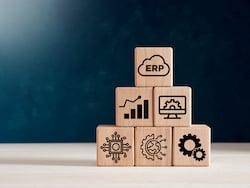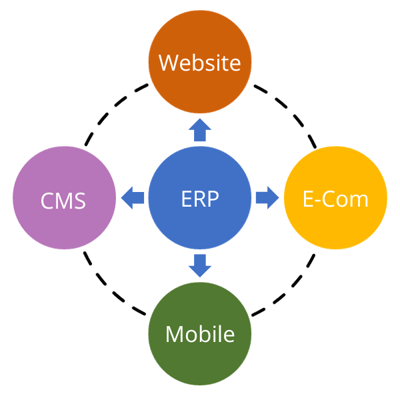 If a “headless” ERP system sounds spooky, it shouldn’t! A headless ERP approach can help improve flexibility, manage costs, and enhance the user experience, with no guillotine required. And, with the right mindset shift, a headless strategy can even be an ideal solution for many legacy ERP systems. PSGi Co-founder and President Larry Dube explained why in his recent webinar. In this blog, we summarize the key points of his presentation.
If a “headless” ERP system sounds spooky, it shouldn’t! A headless ERP approach can help improve flexibility, manage costs, and enhance the user experience, with no guillotine required. And, with the right mindset shift, a headless strategy can even be an ideal solution for many legacy ERP systems. PSGi Co-founder and President Larry Dube explained why in his recent webinar. In this blog, we summarize the key points of his presentation.
If you have time, we invite you to watch the webinar recording using the link below.
What is a headless ERP, and why is it important today?
Whether they are employing a legacy or newer system, just about every organization feels pressure to improve supply chain transparency, keep up with ever-changing technologies, and improve operational awareness.
A “headless” ERP approach provides a solution, offering an avenue for improving the adaptability of ERP software and accelerating its pace of change. A headless ERP model allows the processing power, data, and functionality of ERP software to be accessed independently of the traditional ERP user interface. In a headless approach, data and functionality can be housed in the ERP system and communicated to external systems using application programming interfaces (APIs). These APIs allow for ERP data to be seamlessly shared through web interfaces, e-commerce platforms, mobile devices, and CRM systems. In short, a headless approach gives an organization freedom of choice: ERP functionality built into existing software can be used more flexibly throughout the organization. We break down the strategic benefits of this approach in greater depth below.
Whether or not an organization wants to embrace a headless model, it may increasingly become a necessity as trends like Industry 4.0 further accelerate the pace of change. No organization can afford to re-engineer its ERP system every time a new integration is required; yet more data is flying in from and out to all directions than ever before.

Why Headless? Key Benefits of a Headless Model
#1: Increased Flexibility and Adaptability
The variety of systems that can be readily integrated with ERP software using a headless model can dramatically enhance organizational flexibility to improve supply chain and cross-department collaboration, integrate multiple data sources, link SOPs with Quality Management Systems (QMS), and even bring granular data-driven insights to the shop floor via tablets or other mobile devices.
This benefit is best understood within the context of the other four benefits discussed below. Just about any desired functionality can be baked into a custom ERP implementation; the issue is whether such an effort is timely, cost-effective, secure, or necessary.
#2 Freedom to Build the Best Version of Your Customer-Facing Experience
Competitive pressure is intense, customer expectations are rising, and consumers are coming to expect a more seamless digital experience (both in e-commerce and other digital touchpoints). This pressure creates a breakneck pace of change, and many ERP systems are ill-suited to keep up. A headless approach offers a way to adapt to fast-moving customer expectations without disruptive, costly ERP development work. Whether it is providing more detailed order status through web interfaces or integrating with customer logistics systems, a headless ERP can efficiently accommodate the challenge.
#3: Enhanced User Experience
Many different kinds of users may need to interact with the functionality in an ERP system, and a streamlined user experience for ERP software is about more than aesthetics. An intuitive, modern UI built to reflect the most important day-to-day workflows across various roles and departments can help reduce training requirements, improve uptake, and limit mistakes. A layer of external systems gives organizations the freedom to upgrade and tailor the user experience to scenarios ranging from executive dashboards to factory floor tablets without building a new ERP system, ultimately allowing the ERP to support more data-driven decision-making.
#4: Increased Security
A security failure can be incredibly costly for manufacturers. FACC, an Austrian aerospace component manufacturer, lost $61 million after an attacker impersonated the CEO and requested a large financial transfer to facilitate a transaction. Norsk Hydro, a multinational aluminum manufacturer, lost $75 million to ransomware. Automotive manufacturer Renault-Nissan also suffered a substantial attack, halting production in 5 countries.
In this context, protecting the core, proprietary data held in an ERP system is critical. Security must be maintained at all costs, and a headless model effectively provides an added layer of protection. Data is maintained in a safe core repository in the ERP system, while APIs only provide access to select portions of system data. In short, a headless model makes it easier to provide more users access to relevant, valuable data without the risks that come with direct access to the ERP database.
#5: Cost Control
Implementation is disruptive and expensive. Many organizations find themselves needing added functionality but worried that the costs won’t be worth it. Headless ERP software offers a path forward, allowing the business to move quickly without disturbing core business functionality.
An effective headless strategy should seek to leverage the ERP software’s existing capabilities wherever possible. This allows the organization to take advantage of the processing power available while opening up the option to employ cost-effective “plug and play” as required by the business.
How The Headless ERP Model Can Be Applied to Legacy ERP Software
While some modern ERP software is built from the ground up based on the headless ERP model, this foundation is not necessary to implement an effective headless ERP approach. In fact, a headless ERP model can be an ideal option for many organizations that feel their legacy ERP system continues to deliver exceptional value but could deliver even more value with more streamlined integrations, new functionality, and an improved UI, for example.
When considering whether transitioning your legacy ERP software to a headless model makes sense for your business, here are the most pressing questions to answer:
- Is its core business functionality still solid? This is the most fundamental question to address. If the ERP software is still capable of supporting core business functions, it can likely be substantially enhanced through a headless strategy without the need to switch to new ERP software.
- How much have you invested in your legacy ERP system? Many systems have been invested in heavily over the years and heavily modified to reflect unique business requirements. A headless system can allow these investments to continue generating more long-term value.
- How many APIs are available for your existing system? In many cases, many more APIs are already available than organizations are aware of, and many more can be enabled quickly with just a little development work. In our experience working with many legacy ERP systems over decades, most systems offer interface points that hold broader potential for integration with external systems (even if these legacy systems didn’t yet use the term “API”). For example, just about any ERP system employs distinct modules that must communicate with one another; in many cases, these same API-like communication functions can be leveraged to accommodate integration with external systems.
These questions illustrate why, when it comes to a headless legacy ERP strategy, there is no substitute for understanding the ins and outs of your software and its capabilities. At PSGi, for example, we work extensively with the Power i / IBM i platform; its power and stability cannot be beaten, and the key is understanding and documenting how to make use of the vast array of functionality, tools, and interfacing flexibility it offers.
In summary, a legacy ERP system can function as an effective core for a flexible headless ERP implementation. The key is a shift in mindset toward thinking about your ERP system as a repository of functionality that can be accessed through a library of reusable API and interface points that allow the organization unprecedented adaptability for responding to competitive pressure.
We hope this webinar summary has provided some valuable insight! If you are interested in further details, you can watch the full recorded webinar here.
Or, if you prefer to reach out to the PSGi team to discuss your future ERP plans, contact us here.



